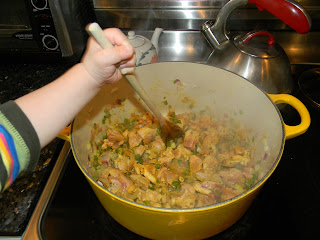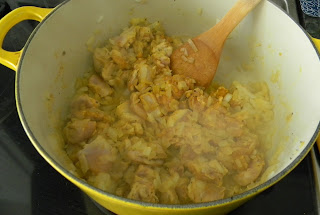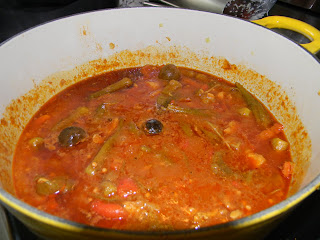Usually when I pass by the celery in the vegetable section, I'm always tempted to just pick off 2-3 ribs-- which is all I ever need. I never need the whole stalk and usually discard half of it because it goes limp in the "vegetable crisper drawer".
Celery has never really been given credit as the main ingredient of any dish except for this recipe that I'm about to share with you. Warning: if you are not a fan of celery's crisp, sour, herbaceous wonderfulness then this recipe is not for you.
Warning #2: I've also been told that celery is an aphrodisiac. Another reason to give celery a try!
There are two ways of making this stew. This is my favorite version which incorporates the use of tomato paste and chicken thighs.
Serves 4-6
Ingredients:
(2) Stalks celery, preferably organic, cut at the base
(1) pound boneless, skin-less chicken thighs, or breast, cut into cubes
(2) bunches Italian parsley
(1) bunch cilantro
(1) medium yellow onion, diced
(1) can tomato paste
(1) teaspoon turmeric
(1) lime, juiced
(1-2) teaspoons cayenne pepper (optional, but if you like spicy food ADD IT)
S/P to taste
1. Wash every rib of celery individually and set aside.
2. Triple wash the parsley and cilantro. Making sure it is free of sand. Set aside. The best method for doing this is rinsing it once. Letting it soak in a bowl of water until all the sand goes to the bottom. Gently removing the herb from the bowl of water and rinsing it again in a colander.
3. Chop the celery into 1/4"-1/2" thickness. Include the leaves.
Finely chop the cilantro and the parsley. It must be done by hand using a sharp knife. Do not be tempted to run it in your food processor as it will not chop evenly and will turn out mushy when cooked.
(This is a lesson I learned from my mom as I've been her right hand "wo-man" in the kitchen growing up and I always watched her chopping everything by hand for Persian stews. I'd tease her saying it'd be much easier/faster in the food processor and then she'd go on telling me it must be done by hand and that if you're inviting other Persians to your home they will know the difference and "scoff" at your Persian stew making if you use the food processor.) I have yet to make any Persian stew for my Persian friends/family--I don't want to be "scoffed" at. Anyway...
In a large pot heat a tablespoon of oil. Saute the chopped parsley and cilantro for 2 minutes. Add the celery and saute for 4-5 minutes. Pour the contents into a heat proof bowl and set aside.
In the same pot, heat another tablespoon of oil and saute the diced onion for 2-3 minutes. Add the cubed chicken and saute for 4-5 minutes. At this point add all your other seasonings: turmeric, tomato paste, lime juice s/p, and the optional cayenne.

Pour the reserved celery, and herbs back into the pot. Give it a good stir. As you see in the picture above, I have a little kitchen gnome that helps me with the stirring. Add about 2 cups of filtered water or chicken stock and bring to a boil for 10 minutes.
Reduce to a simmer, cover and cook for 2-3 hours on low heat. Check it every now and then with a good stir. You'll know the stew is ready once all the ingredients have "settled" together.
Serve it with steamed saffron basmati rice and "tahdiq" (a.k.a. the rice on the bottom of the pot that is crispy)
This is a great fall/winter stew. It can even be enjoyed on its own or with crusty bread.
Nousheh jan!
Vegan option: The omission of chicken in this stew makes it vegan. You can substitute your protein by using firm tofu that can withstand the process of "stewing" or adding a can of garbanzo beans and kidney beans.






















































